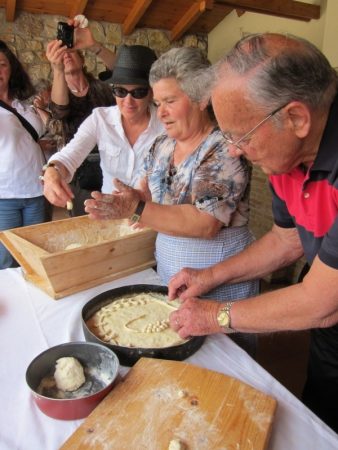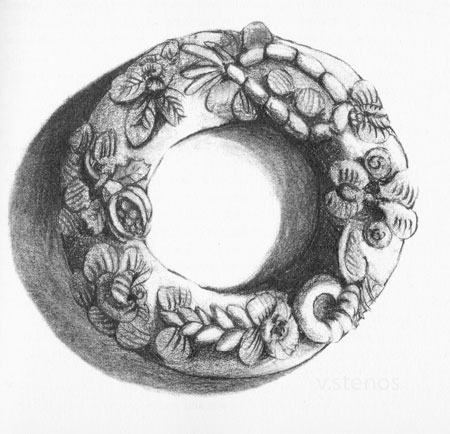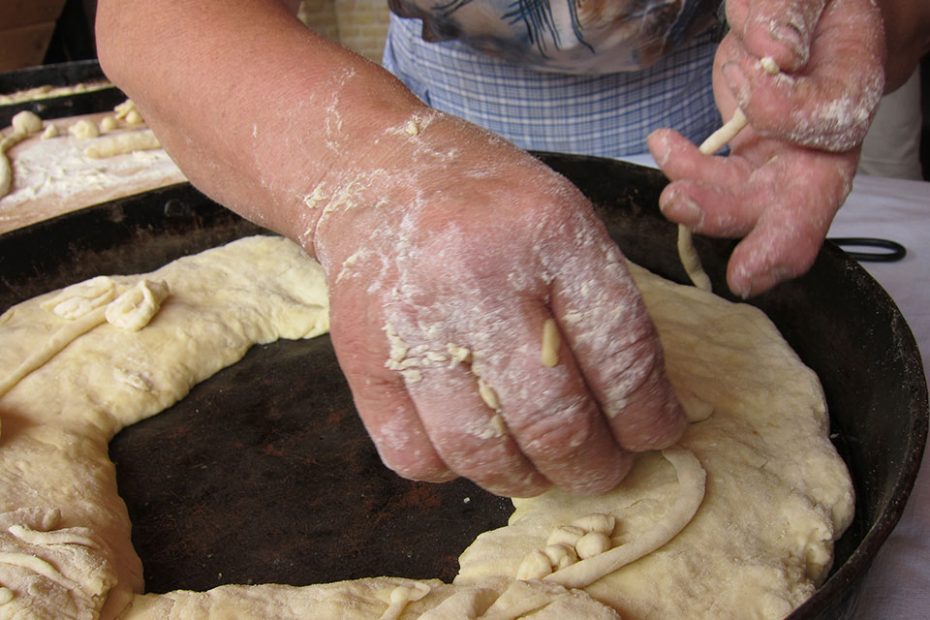Many of us are familiar with Vasilopita, the “lucky” New Year’s bread with the coin inside, or with tsoureki, the braided Greek Easter bread. Both are delicious, but also symbolic. They are the rock stars of Greek bread traditions, the most famous; there is a whole littany of other festive breads, handmade by artisan home bakers, that could and should be considered an art form. In every family or village, there were (and still are) a few skilled home bakers, usually women, whose nimble fingers can sculpt ornate decorations to fit upon the surface of the local festive bread. From Crete to Northern Greece and all throughout the islands, the number of traditional sculpted breads is mind-boggling. They are almost always spiced with aromas like cinnamon and cloves, or enriched with nuts.
In agrarian communities, long before the advent of pre-fab loaves and high-tech ovens, bread was two things to almost all people: the daily sustenance and the tableau upon which the milestones, trials, tribulations, hopes and fears of life were carved. Decorative and highly symbolic breads and bread customs were part of life in Greece long before Christianity took root. In fact, many of today’s religious bread customs were co-opted from ancient pagan ritual.
The importance of bread has to do with the importance of wheat, the staff of life, in the Mediterranean. Its growing cycle is rife with symbolism, from the myth of Persephone, Demetra and Hades to the Christian imagery of bread as the symbol of God and of Christ, often called the Bread of Life. Special breads are baked to celebrate marriage and birth and commemorate death. At Christmas they are made to symbolize hope for the crops and the fortunes of the family in the coming year.

Making festive, decorative bread in Crete.
Despite a wealth of regional variations, the figures sculpted in dough on top of these loaves are often similar, although some are related specifically to crops or farming traditions of a specific area. Yokes, threshing tools and wheat staffs are common, as are sheep and shepherds. In parts of Macedonia oxen are almost always one of the sculpted decorations. In Kastoria, for example, farm families make sweet biscuits in honor of their animals. In Thrace, where both farming and husbandry have been traditional professions, sheep, cows, oxen and sickles are part of the bread decorations.
Among the itinerant shepherd communities of northern Greece, especially among the Sarakatsanoi, Christmas bread garnishes include all the tools of their lifestyle: sheep, ewes, the hut and its fence, the shepherd with his long woolen cape, his staff, buckets for millk,even sheepdogs are sometimes depicted. Grapes, grapevines and daisies (the number of petals are representative of the number of family members) are often sculpted, as are some symbols we usually interpret as representative of evil, such as the snake. These, explains the author, Nikos Psilakis, in his excellent book [in Greek], “The Bread and Sweets Traditions of the Greeks,” explains was a way of neutralizing these forces. “In villages, people thought it good luck to find a snake inside the house and that killing it would bring misfortune.”

Decorative Bread Drawing by Vassilis Stenos
But most common of all the Christmas bread symbols in Greece is the cross motif or the Greek letter X, the start of the word “Christ.”
Overall, these ornately sculpted figures, often created by teams of women, fellow villagers or family members represent good wishes for a prosperous harvest, as well as a kind of magic. It’s as though placing the figures on the bread protects the crops, animals and family.
All the foods of fertility and prosperity as interpreted by agrarian societies, enrich these loaves: dried fruits, nuts, sesame seeds, spices and honey or sugar foremost among them. Their typically solid round shape, sometimes with a dough cross studded with nuts baked into the top (see recipe below), is symbolic of the cycles of nature and life, of eternity.
The bread has to be broken, or sacrificed, but not necessarily consumed, and tradition has it that year in and out it must be broken by the same member of the family, usually the male head of the household who will first make a sign of the cross over the loaf. In some parts of Greece, a piece of the Christmas bread takes its place near the family icons, which many families still keep in a corner of the house. Elsewhere, it is brought to church as an offering or set among burning incense.
There are endless traditions surrounding Greek symbolic holiday breads. The Christmas and New Year’s breads are baked with that which springs eternal: Hope. This year, more than any other perhaps, every Greek household should dig out their old recipe books to find the Christmas bread that will spread some cheer during what promises to be a tough year.
Here’s my recipe for a delicious spiced Greek Christmas bread, sure to spread some holiday cheer!






